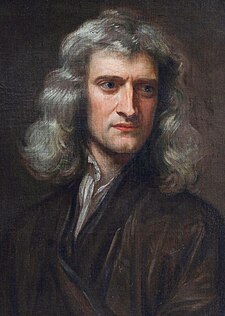From Wikipedia, the free encyclopedia
Isaac Newton (tí wọ́n bí ní Ọjọ́ kẹrin oṣù kìíní ọdún 1643 - ọjọ́ kọkànlélọ̀gbọ̀n oṣù kẹta 1727) jẹ́ onímọ̀ sáyẹ́nsì ọmọ orílẹ̀-èdè Gẹ̀gẹ̀ẹ́sì. Ó jẹ́ amọ̀ye ninu ẹ̀kọ́ ìsirò, awòràwọ̀, ẹ̀sìn àti ònkòwé. Ní ìgbà ayé rẹ̀, wọ́ń mọ si amọ̀ye ohun gbogbo. Látìnì: Philosophiæ Naturalis Principia Mathematica, ìwé ti ó kọ ní ọdún 1687 jẹ́ ìpìlẹ̀ fun ìsisẹ́ẹ̀ro ayébáyé (nínu ẹkọ́ọ físíìsì). Ìwé yìí wà nípa òfin ìsirò lóri ìmọ̀ye ìṣẹ̀dá, ó sìm jẹ́ awọn ofin akọ́kọ́.
 |
Àyọkà yìí tàbí apá rẹ̀ únfẹ́ àtúnṣe sí. Ẹ le fẹ̀ jù báyìí lọ tàbí kí ẹ ṣàtúnṣe rẹ̀ lọ́nà tí yíò mu kúnrẹ́rẹ́. Ẹ ran Wikipedia lọ́wọ́ láti fẹ̀ẹ́ jù báyìí lọ. |
| Sir Isaac Newton | |
|---|---|
 Godfrey Kneller's 1689 portrait of Isaac Newton (aged 46) | |
| Ìbí | 4 Oṣù Kínní 1643 [OS: 25 December 1642][1] Woolsthorpe-by-Colsterworth Lincolnshire, England |
| Aláìsí | 31 March 1727 (ọmọ ọdún 84) [OS: 20 March 1727][1] Kensington, Middlesex, England |
| Ibùgbé | England |
| Ará ìlẹ̀ | English |
| Ọmọ orílẹ̀-èdè | English (British from 1707) |
| Pápá | physics, mathematics, astronomy, natural philosophy, alchemy, theology |
| Ilé-ẹ̀kọ́ | University of Cambridge Royal Society Royal Mint |
| Ibi ẹ̀kọ́ | Trinity College, Cambridge |
| Academic advisors | Isaac Barrow[2] Benjamin Pulleyn[3][4] |
| Notable students | Roger Cotes William Whiston |
| Ó gbajúmọ̀ fún | Newtonian mechanics Universal gravitation Calculus Optics |
| Influences | Henry More[5] Polish Brethren[6] |
| Influenced | Nicolas Fatio de Duillier John Keill |
| Religious stance | Arianism; for details see article |
| Signature | |
Notes His mother was Hannah Ayscough. His half-niece was Catherine Barton. | |
Seamless Wikipedia browsing. On steroids.
Every time you click a link to Wikipedia, Wiktionary or Wikiquote in your browser's search results, it will show the modern Wikiwand interface.
Wikiwand extension is a five stars, simple, with minimum permission required to keep your browsing private, safe and transparent.